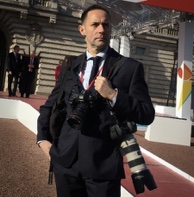
For authors, the creation of their book’s cover is often a very personal process. After all, the cover should be what best represents the content of the book, and no one knows the content better than the author herself. So, I was thrilled when I got the opportunity to speak with an author named Cécile Barlier about the process of creating the cover for her book, A Gypsy’s Book of Revelation.
A Gypsy’s Book of Revelation is a collection of short stories released by Red Hen Press on April 6, 2021. The collection is a very wide array of different writing styles and subject matters, and although each story is so vastly different from the next, they do have something in common—they explore different elements of the human condition, and each could be thought of as being its own snapshot of life. While she loves all of her stories dearly, Cécile reports that there is one particular story that stood out to her, ultimately becoming the book’s namesake.
The short story follows a deceased Roma woman who attends her own cremation, having a conversation with her children from beyond the grave. While seeking inspiration during the drafting process, Cécile looked online and found a beautiful portrait of a Roma woman and a child, shot by Jeremy Sutton-Hibbert, a photographer from Scotland. Tethering herself to this woman as the face and imagined voice of her narrator, she had the image on her screen 24/7 as she wrote. “She fueled me,” Cécile recounts, “and it felt like she was really looking at me, mocking me, daring me to write her story, and I think that her presence and her gaze helped me to keep steady and push forward.”
Through the process of pulling inspiration from this Roma woman, Cécile developed a deep emotional connection with her, and so when Red Hen Press approached her about the cover, she immediately knew that she wanted to use this woman’s picture. As Cécile puts it, “She came to mind immediately, since she was literally my muse, and I knew I’d really love to have her photo be the cover. In this way, the cover came about quite organically.”Red Hen Press was supportive of her choice, and so Cécile reached out to Jeremy Sutton-Hibbert and asked for his permission to use his photo.
Jeremy, thankfully, was on board with the idea from the onset. Jeremy, who has now been a photographer for thirty-one years, tells me in a separate interview about the picture’s backstory. “I first started visiting the Roma camp of Sintesti, in Romania, in 1990,” he tells me. “I photographed this particular woman and child around 1993. Sadly, I don’t have their names, and I haven’t seen them since. I’ve been incredibly fortunate to be given access and permission to spend time there at that camp, and the photography I’ve produced documents an almost 30-year span of life in the camp.” While in conversation with Jeremy, I get the sense that these people, these memories, hold a very special place in his heart. After all, he got the rare privilege of documenting life in a very private community, occasionally even shooting the weddings of people he’d taken pictures of when they were babies. Listening to Cécile and Jeremy talk about the Roma woman and the child, the subjects of the book’s cover, I feel the love they share for these strangers.
However, getting Jeremy’s permission to use the image was only half the battle for Cécile—now she had to consider composition. Red Hen Press presented a few options that were more on the whimsical side, but Cécile voiced her desire for a more sober composition. “I wanted something that was very close to the photograph, that didn’t require a lot of treatment; the picture is so powerful in and of itself,” she tells me. Although Red Hen Press’s marketing team and sales reps liked the earlier, more whimsical designs, they were dedicated to bringing Cécile’s vision to fruition.
Natasha McClellan, Red Hen Press’s Production Associate, tells me that, “While all Red Hen covers are finalized by our talented team of in-house designers, the author is always involved in the process. It’s important that an author has the opportunity to play an active role in the creation of their book, so if we present them with something that they’re not on board with, we try to approach it from a new angle.” In light of this flexibility and understanding, Cécile immediately knew who she wanted to bring onto the team—her good friend, Vincent Maxime Daudin, who was based in France at the time.
As the founder and creative director of VMD (Vision Meets Design), a creative consultancy, it would be safe to assume that Vincent is a “visual guy.” He read Cécile’s book over the span of a couple days, and immediately affirmed her cover choice. “Jeremy Sutton-Hibbert’s powerful image was the clear way to go,” Vincent tells me, “because it provocatively captures the ‘human’ quality of the book’s key messages. The daredevil girl’s empowering attitude, the innocent kid’s hopeful expression… This picture is also full of contradictions: misfortune and opportunity, resignation and resilience, fortitude and vulnerability.” Vincent also agreed with Cécile’s desire for a more sober composition, and brought up the idea of a gradient filter that colorized Jeremy’s classic black and white photo, adding more depth to it. He proposed different options with subtle variations in color, font treatment, and placement, and the two old friends brainstormed together, ultimately coming to a conclusion that they were both happy with.
Listening to Cécile, Jeremy, and Vincent talk about their collaboration makes my head spin a little bit—after all, we’ve got a French woman writing in Northern California, a Scottish photographer taking pictures in Romania, and a designer operating out of France. It almost sounds like the introduction to one of those “three men walk into a bar” jokes. So, I can’t help but ask the three of them, what did the process of international creative collaboration look like?
“I think it was very spontaneous and natural, like any good story,” Cécile tells me. “One thing led to the next for us, and everything seemed to just flow—so, even though we were very far away from each other, it felt easy.” Jeremy and Vincent agree, with the common observation being how today’s technology allowed them to connect and collaborate in ways previously unimaginable. “I feel that we have become friends,” Jeremy tells me, “although that’s not always the case when doing this sort of thing.” Everybody working so well together on a project like this doesn’t always happen, and so Cécile reports that receiving so much support throughout the process of publishing her first book was a pleasant surprise for her.
In our conversation, Cécile does not forget Red Hen Press or their role in the creation of her cover. “They were very easy to work with,” she tells me, “and they were very open—they could have not agreed with my choice for the cover and made me do something else, but they were very supportive. They gave me a lot of leeway and a lot of freedom, which I’m deeply appreciative of.” Natasha confirms, stating that
“We aimed to bring her vision to fruition while still creating a beautiful, marketable book and, ultimately, I believe we succeeded. Our goal is always to create a cover design that is marketable and that the author can be proud of.”
Aside from marketability, there is also the matter of message. Images of any sort have the power to impact and change people. As Vincent puts it, “Photography instantly engages us on a deep emotional level, connecting all of our memories and experiences. We are saturated by a constant flow of imagery on social media, so being truly moved by an image becomes a challenge for photographers.” It’s commonly known in photojournalism that pictures convey a story, and that it is the role of the photographer to capture an image that is as genuine and authentic as possible (i.e., not staged)—the authenticity of Jeremy’s image is what captivated Cécile, and it’s what captivates me. Jeremy tells me, “I hope my work can perhaps make the world a little more understood, or a smaller place, or break down misunderstandings through showing my images. So when one of my images has an impact on someone, such as this one did with Cécile, then I hope I’ve achieved something.”
I want to end on the fact that pictures have the ability to bridge gaps, and as Cécile recently learned, promoting authenticity can have an incredibly inspiring impact. “Jeremy posted the final cover image on his social media,” she tells me, “and soon enough he was contacted by a Roma woman who he had met through work. She asked whether or not she could be put in contact with me, and I have recently received a note from her. She explained that my cover and my title really intrigued her, and then she told me a story: ‘You see, I am a gypsy,’ she told me, ‘and I’m writing a book on the story of going from a very uneducated family, where my grandmother never learned how to write, to me working for Google now. I am no writer, but I have a story that I know can help many girls like me find hope and education.’ This woman reached out to me for advice, and it really moved me in more ways than one. I am not a Roma woman, but to think that such a connection could be created because of the cover felt so improbable, meaningful, and beautiful. Writing is a lonely undertaking, and yet it’s an incredibly connecting one.” That, I think, is both beautiful and true. As creatives, we have the power to encourage, uplift, and empower—however, if not careful, we also have the power to do the opposite. We have a responsibility to be mindful of our message, and at the same time, what a privilege it is to have the opportunity to touch lives. And to think, all of this can be accomplished through a cover alone!

Cécile Barlier, a French author, has been writing for nearly fourteen years now. Her main job is working alongside her husband, Pierre, as an entrepreneur—together, they bring reusable bags to grocery stores in the U.S. such as Whole Foods, Costco, and more. Having written short stories for many years, A Gypsy’s Book of Revelation is Cécile’s first published collection, and is the recipient of the Grace Paley Prize for Short Fiction.You can find Cécile at www.cecilebarlier.com.

Jeremy Sutton-Hibbert is a freelance reportage photographer based in Scotland. His job, which he has now had for thirty-one years, has allowed him to travel the world, leading him to more than one hundred different countries and introducing him to all different sorts of people. His work has been published in newspapers and magazines alike. You can find Jeremy at www.jeremysuttonhibbert.com.

Vincent Maxime Daudin is the founder and creative director of VMD—Vision Meets Design. VMD is a creative consultancy with an emphasis on brand strategy, trend forecasting, and style consulting. With major clients in the US, China, and Russia, and with over twenty-five years of experience in trend forecasting, Vincent has established himself as a creative powerhouse in the field. You can find Vincent at www.visionmeetsdesign.com.

Red Hen Press is a nonprofit publishing company committed to promoting new authors, supporting diversity in publishing, and pushing for literacy in local schools. They seek to broaden readers’ horizons and provide authors with a publication that they can be proud of. You can find Red Hen Press at www.redhenpress.org.

[cm_page_title title=”Continue Reading” subtitle=” Shelf Unbound”]
Article originally Published in the April / May 2021 Issue: Cover Stories.
